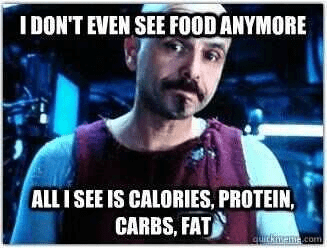Macronutrients make up your daily calories. Macronutrients come from PROTEINS, CARBS, and FATS, and you need to eat all three to survive. To understand macronutrients and how truly optimise your nutrition, the simplified version is this: you just need to know, understand, and be able to recognise which foods are carbs, which ones are proteins, and which ones are fats. And then know how much of each you need to eat. It’s not hard, but with everything, people like to make it hard. First, learn what macros are. With any food, you have three options. It’s either
- A protein source
- A carbohydrate source
- A fat source
The easiest way to figure out what you’re eating is to read the label. Whatever the larger number on the label between the three macronutrients, that’s the winner. If you’re reading the label on the peanut butter jar, peanut butter is a FAT because there are about 16 grams of fat per serving and only about 7 grams of protein and roughly 4 grams of carbs. (I’m going off my memory here. And now I’m hungry for peanut butter.) If you have no label (you bought some asparagus at the farmer’s market) know that all veggies are a carb source—a great carb source at that. Most cheeses, nuts, and nut butters are a fat. Meats and most non-cheese dairy are protein sources. If you have no idea, you can always use Google to figure out if your food choice is a protein or a fat if it doesn’t come with a label. If you’re eating chili cheese fries somewhere, know that’s a carb and a fat, and it’s clogging your arteries. 
- Muscle Protein Synthesis: Muscle tissue is made up of proteins. When a person puts stress on a muscle, such as lifting weights, proteins become damaged. Protein synthesis is the repairing of damaged proteins and replacing them with replicas of the original. The new muscle tissue is stronger and able to handle stress better than before. This is how muscle building works.
So what is so great about muscle? Aside from being able to function better in life and looking great—adding muscle helps you lose fat. The thing is, muscle needs energy. A pound of muscle uses up to 150 calories a day, whereas a pound of fat only needs about 3 calories a day. Simply having a lot of muscle burns calories. Just remember—body fat does not need energy to maintain itself and muscle does, so you have to put in the time to lift those weights to spark the protein synthesis. What does this have to do with eating protein? A moderate serving of high-quality protein maximally stimulates skeletal muscle protein synthesis in young and elderly subjects–Journal of the American Dietetic Association, 2009. According to a 2008 study in the American Society for Nutrition, ingesting just 20g of dietary protein post workout is enough to maximize muscle protein synthesis after resistance exercise.
- Thermic effect: Before I explain thermic effect, let us look at a different term—metabolism: the term commonly used to describe the process of breaking down food and turning it into energy. Most people have heard that in order to lose weight a person wants a high metabolism to burn off calories right? This is true. But what raises your metabolism?
Ironically, one of the best ways is eating. Food has what is called a thermic effect, which is the energy the body needs to eat, digest, and metabolize food. After you eat, your Basal Metabolic Rate (BMR) begins to rise. This rise can be fairly meager or it can be quite significant depending on how much you ate and the types of foods you ate. According to shapefit.com, fats generally raise your BMR by about 4%, carbohydrates by about 6%, and proteins by a whopping 30% –wowzers! I have read other studies that suggest the thermic effect of protein is lower than the shapefit.com estimates, but everyone seems to agree that the thermic effect of protein is at least double that of your other macronutrients—carbs and fat.
- Increase in Glucagon: Consuming dietary protein increases the peptide hormone glucagon. Glucagon raises concentrations of glucose in the bloodstream –it does the opposite of insulin—this leads to greater fat mobilization. Glucagon and insulin both help to regulate blood sugar.
Basically, an increase in glucagon leads to greater fat loss during calorie restriction and less fat gain during overeating.
- Cardiovascular Health: Multiples studies have shown that when people replace around 15% of their calories from carbohydrates with calories from protein, this lowers LDL cholesterol and triglycerides.
- Satiety and Prevention of Weight Cycling Effect: A study found the fat loss success of many low carb diets had more to do with the increase in protein consumption than the reduction of carbohydrates. That study concluded that dietary protein was an effective treatment of obesity in that it improved metabolic function, increased satiety and energy levels, and decreased the weight cycling affect—the cyclical loss and gain of weight often referred to as yo-yo dieting.

- Birds
- fish
- eggs
- cow
- chicken
- lamb
The list goes on. Just like you’ll see with veggies, it is always a good idea to eat a wide variety of meat. Chicken might be a great source of lean protein; however, certain fish varieties will provide a better concentration of healthy saturated fats, beef will provide a quality source of iron and new amino acids, and eggs are loaded in nutrients that are not easily acquired in other food forms. Also animal meat, especially fish, is dense in Omega 3’s—DHA, EPA, and ALA and you need all three. ALA you can get from plants. But non-meat eaters should be taking fish oil to get adequate amounts of DHA (over 30% of your brain is made up of this stuff) and EPA (an important anti-inflammatory). How can I get 20 grams of protein post workout quickly and easily? I don’t have time to cook meat, I know I shouldn’t eat processed meats; what is a busy person to do? This is where supplements are useful and probably necessary. If you’re in the very beginning stages of healthy eating and food planning, I don’t think supplements should be a high priority; however, quality protein supplements can be an excellent way to meet your dietary protein demand–especially for the person with a busy lifestyle. In addition, supplemental protein like whey protein can provide you with powerful anti-oxidants, lower high blood pressure, and increase lean muscle mass. Next: How much protein should a person eat? As a general guideline, you should get about 20-30% of your calories from protein. Eating 30% of your calories from protein will help you to increase your fat loss, provide you with satiety—that full feeling, and provide you with the necessary energy to start your new fitness regimen. Let’s assume you are eating about 1800 calories per day. Thirty percent of 1800 is 540 calories. A gram of protein is 4 calories so that means a person on an 1800 calorie plan should be eating about 135 grams of protein a day. As you begin to add in more resistance training you can increase your calories by increasing the amount of protein you consume. Consuming protein after a heavy weight training session with some simple carbohydrates can actually help fight muscle soreness, increase muscle synthesis, and decrease body fat. Wow—sign me up, right?! NEXT UP: FATS Fats sound like they would be bad for you—I mean that stuff we are trying to get rid of is called fat. If you learned about nutrition in the 1980s (or your current nutrition expert/teacher studied in the 80s) then you probably think fat is bad. But for those who somewhat keep up with science, you know that most fats are actually pretty good for you. And by most fats I mean the naturally occurring fats—saturated, unsaturated, polyunsaturated—they are all good (mostly). 
- Vegetables
- Breads, cereals, and other grains
- Dairy, milk and sugar-sweetened milk products
- Foods containing added sugars (e.g., cakes, cookies, and beverages).
- There are two main types of carbohydrates:
- Complex carbohydrates
- Simple carbohydrates

- Other vegetables
- Oatmeal
- Berries
- Other fruits
- Nuts and seeds (typically not thought of as a carbohydrate but many are fiber dense)
- Beans and Peas
- Quinoa
- Brown rice
- Other grains
Whole wheat breads and pastas (though for best results we recommend limiting quantities of these) How many carbohydrates should a person eat? As a general guideline, you should get about 40-50% of your calories from carbs. Forty percent of your calories from carbs will help you feel full–especially since we advise you to choose ones that are slow digesting and high in fibre. These choices help your digestive system, fuel your activity, and even help you process activities throughout the day. Carbs also provide you with the necessary energy to fuel your fitness regimen. Before we tell you how to choose smarter carb sources, we want to make you aware that sugar, (a carb!) is hidden in many different food items. It’s important to have a good understanding about where to look in order to avoid unnecessary, non-nutritional calories. How can You Avoid Added Sugars? Look for these ingredients as added sugars and make note to avoid these products as much as possible: Corn syrup
- Dextrose
- Fructose
- Glucose
- Sucrose
- High Fructose Corn Syrup
- Invert Sugar
- Brown Sugar
- Malt Syrup
- Molasses
- Corn sweetener
- Fruit juice concentrates
- Raw sugar
To avoid added sugars, REMEMBER: Always choose water over sugar-sweetened sodas and juices. If you must drink juice, find one made from 100% fruit juice and then dilute it with water. Breakfast cereals (which are mostly simple sugars or have sugars added) are one of the worst sugary foods that we don’t normally think about. Look for ones that contain 4 grams or less of sugar. Again, carbs come in all sizes and shapes. In the end–they are made up of sugar. It’s up to you–and always will be–to decide which ones you will choose for your body. And while I fully believe that a little bite of chocolate here and there isn’t going to kill anyone, just remember that moderation is key. What WE want to convey is that sugar can do a lot of damage if not kept in moderation. So be mindful of your food choices…now and always! And yes, fruit really does make a better dessert option! When it comes to dessert or your sweet tooth, there’s nothing wrong with saving your fruit for these moments! I’m not going to tell you to never eat sugar but I will tell you why sugar isn’t good for you. And while I hope you learn how to make the healthier food choices you need to live a longer, healthier life, I still hope you have a cupcake on your birthday or your favourite candy on Halloween. There is a true balance to living life healthy and happy—and that includes your sanity too! Balance is healthy. And if you want your candy, eat it after your workout: simple as that. So where should you get the majority of your carbs from if most carbs do in fact, convert to sugar? From VEGETABLES! Eat Your Vegetables! When it comes to vegetables, variety is really important! Remember variety is critical–choose a variety of colours but make sure green is the primary colour. It’s super important to remember to try as many different veggies as possible. It’s easy to pick a couple that are easy and familiar—I can suffer from this sometimes as well. I know what I like, what I don’t, and honestly, I’m not always sure what to do with things like Bok Choy or Dandelion Greens. BUT every vegetable is incredibly dense with a wide variety of nutrients, and it really is important to try new things, so why not start now? Micronutrients are essential for nutrient optimization. If I told you that you could eat 2500 calories a day and you could have 250 grams of carbs (1000 calories worth of carbohydrates), you could easily fill those 1000 calories with a bowl of ice cream, a doughnut, and a couple chocolate chip cookies, right? Heck, you could probably even have a pumpkin spice latte too. Would you feel good? Would you perform optimally? Would you be an overall healthy person? No. Where are your MICROnutrients? Where’s your fibre? How are you optimizing your calories? While making sure to hit your appropriate protein, fat, and carbohydrate goal each day, you’ve GOT to make sure you’re taking in enough fibre daily. That’s about 25-35 grams of fibre each day. If you can eat 30 grams of fibre over the course of the day, and especially through a variety of fruits and vegetables, there’s no way that you aren’t optimizing your nutrition. My typical day includes getting my carbs and fibre from spinach, oatmeal, rice, potatoes, kidney beans, squash, sweet potatoes, cauliflower, , berries, and other fibrous foods. It’s really hard to eat foods that aren’t nutritionally sound and stay within my calorie totals. I “might” be able to squeeze in a doughnut if I decide to cut out the fruit.
- A) I can have it if I choose to, and B) Because I know how many carbs I need to eat and how much fibre I need to take in, I don’t overeat any of my macronutrients.
I now know how to optimize my calories, eat what I need to, how to have a treat when I want one, and still get my desired results. Eating your correct macronutrients while aiming for the best micronutrient choices will lead you to the best shape of your life.


